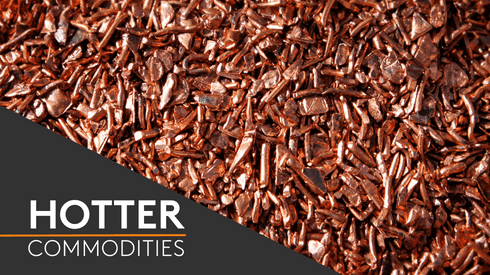This bout of profit-taking seems to be driven by a rebound in the dollar, pushing most commodity prices lower, in spite of a continued positive global risk appetite, easier financial conditions in China, and positive economic data out of Japan.
This comes after a solid session on Monday in which the London Metal Exchange Index recorded a gain of 1.1%. Monday’s strength across the base metals was mostly driven by short-covering, judging by the fall in open interest, with the exception of zinc (+1%) and tin (+0.2%), the only two base metals which have seen some fresh buying, evident in the rise in their open interest.
Precious metals are little changed this morning, with palladium (+0.1%) being the only metal in positive territory. Similarly to base metals, the uptick in the dollar exerts downward pressure on the precious metals space. This follows an average gain of 0.5% on Monday, where silver (+0.9%) performed the best and platinum (+0.2%) was the laggard. The strength in precious metals was driven by a supportive macroeconomic backdrop in which the dollar and US real rates pushed lower, eliciting a further increase in long positioning.
On the Shanghai Futures Exchange today, the base metals complex is under downward pressure, showing an average loss of 0.8%. Aluminium (-2.2%) is the weakest, while copper (-0.1%) is the most resilient. Spot copper prices in Changjiang are up by 0.3% at 54,420-54,520 yuan ($8,450-8,466) per tonne and the LME/Shanghai copper arb ratio stands at 7.59, up from 7.53 on Monday.
Equities continue to push higher this morning. In Asia, risk is “on”, with the Shanghai Composite Index up by a meagre 0.13% after a negative session on Monday (-0.53%) – its first since the start of the year. While European stocks (Euro Stoxx 50 closed at 3,607) were little changed on Monday, US stock markets reached fresh record highs although the volatility (ie, CBOE Volatility Index) ticked up, which could portend a possible consolidation in the weeks ahead.
The dollar index – at 90.47 this morning – is marginally higher after falling for a fourth day in a row on Monday. It remains close to its lowest since December 2014. Monday’s fall in the dollar was mainly due to further strength in the euro caused by hawkish rhetoric from European Central Bank (ECB) governing council member Ardo Hansson, arguing that the ECB’s quantitative easing could end in one swoop after September. With most major central banks from the developed world showing the intention to tighten their policy stance this year, the market is inclined to shift its focus to policy convergence from divergence. This is likely to keep the dollar under downward pressure for some time, which is positive for commodities.
On the macroeconomic front, Japan offered its tertiary industry activity report for November earlier this morning, which surprised on the upside. Looking ahead, investors will pay attention to German final consumer price index (CPI) and wholesale price index (WPI) for December and perhaps more importantly, the Empire state manufacturing index for January in the United States. This could affect global risk appetite, thereby having implications for the metals complex.
Base metals are likely to resume their technical uptrend in the coming days after this current bout of profit-taking comes to an end. Considering the strong gains made in December, it is not a surprise to see base metals consolidating a bit from current price levels. But with a continued positive global risk environment fueled by positive macroeconomic data releases and an overall weak dollar, base metals remain in a sweet spot, leading us to expect investors to further increase their long positioning in the complex.
Precious metals have further room to the upside thanks to this supportive macroeconomic environment in which the dollar is weak and US real rates are not rising meaningfully because of steadily rising inflation expectations. That said, we acknowledge that speculators have already substantially extended their long positioning in the precious metals space in recent weeks, which raises the likelihood of a pronounced sell-off should the macroeconomic backdrop turn unfriendly for precious metals. But for now, we feel better riding the wave rather than fighting the uptrend.
Metal Bulletin publishes live futures reports throughout the day, covering major metals exchanges news and prices.




